Original URL: https://www.theregister.com/2013/12/06/review_wd_black2_dual_drive_ssd_hdd_combo/
Bigger on the inside: WD’s Tardis-like Black² Dual Drive laptop disk
The world’s first SSD-HDD combo... and possibly the last?
Posted in Personal Tech, 6th December 2013 10:28 GMT
Review The phone call from Western Digital's people promised me “a completely new category of hard drive”. Naturally I was sceptical. After all, what could possibly be new in the world of rotating magnetic media – and don’t we all just want fast SSDs anyway?
In fact, there’s no denying that WD has indeed delivered something new and, for the time being, the Black² Dual Drive is unique. It looks exactly like a regular 2.5-inch Sata drive yet it combines a 120GB SSD and a 1TB HDD in the same, 9.5mm-thick package. It will fit inside all but the very thinnest laptops, which demand a 7mm drive.
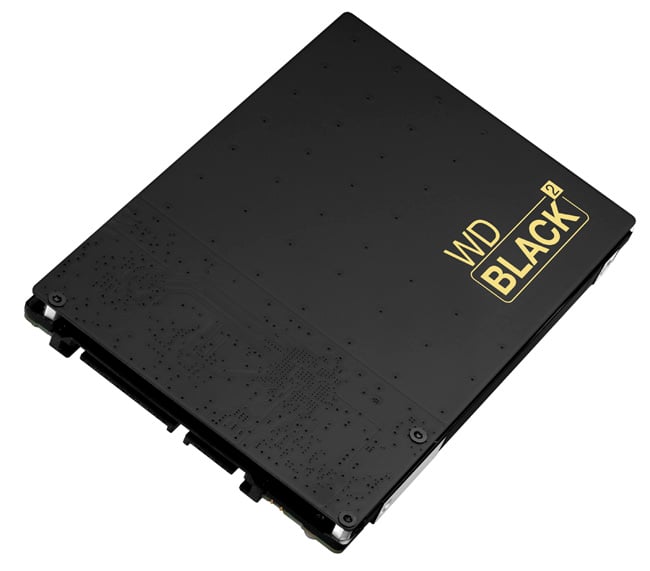
Two-for-one: WD’s Dual Drive
Why bother? SSD technology is tailor-made for laptops. A combination of low power, silent operation, high performance and invulnerability to shock damage are just what the notebook doctor ordered, and if you could buy a 500GB SSD for a hundred quid, laptop hard drive sales would evaporate.
They’re not that cheap, of course, which is why any desktop PC user who cares about performance will boot their machine off an small SSD but store their data on one or two absurdly cheap 3.5-inch hard drives. 120GB of Samsung 840 SSD for £75 and 3TB of Toshiba DT01ACA for a further £80? Job done.
Laptop users are hamstrung by their single drive bay so must choose between an expensive SSD, a cheap hard drive that slays performance, or pay a £25 premium and step up to a hybrid drive that adds 8GB of flash to a hard drive. Hybrid technology works well for files that you use regularly, such as your operating system, but doesn’t offer any advantage over a plain old hard drive for random data.
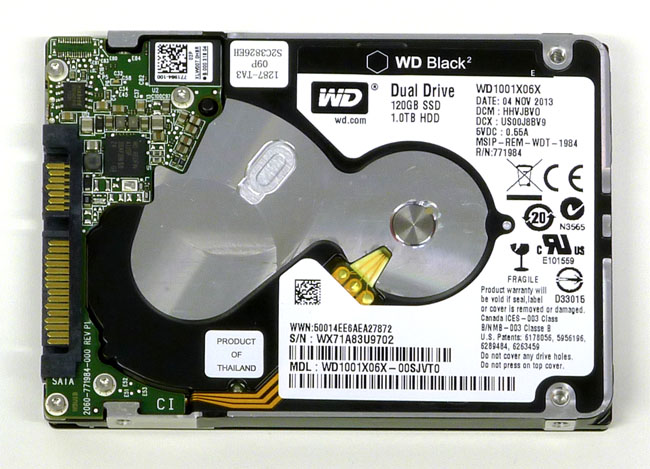
7mm 2.5-inch SSD, meet 120GB of Flash chippery
The Dual Drive gives the laptop user essentially the same configuration that the desktop user has: a 120GB SSD to accommodate the OS and applications, but also a 1TB HDD for movies, music and photos. The clever part of the deal is the way that WD has packaged two drives into a standard laptop drive housing and connected both through a common Sata interface.
WD is being surprisingly cagey about the details of the hardware. However, it boils down to a 7mm-thick 1TB WD Blue laptop HDD with a board and a handful of flash chips, plus a Marvell bridge chip to tie the whole lot together, mounted on top.
I was assured by WD that the Blue HDD is a single-platter model, which is impressive as an areal density of 500GB, let alone 1TB, per 2.5-inch platter is good going. This led to a suggestion from WD that the drive in question might be a custom model which, if true, suggests that 2TB twin-platter drives are just over the horizon.
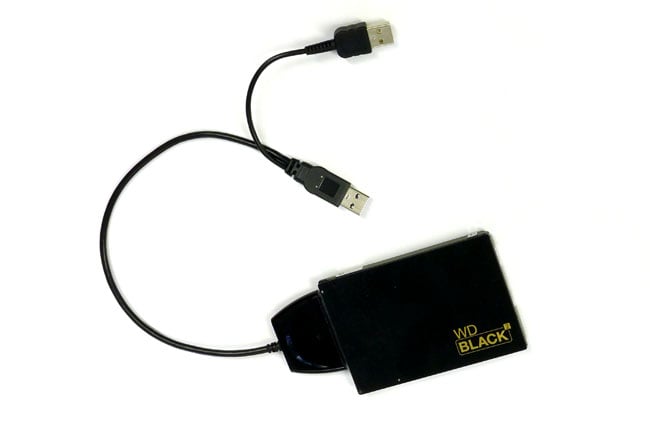
The Black² comes bundled with an adaptor cable for cloning
The Dual Drive comes with an impressive five-year warranty. However, it seems that the warranty will be used to replace either the broken SSD or the HDD, but not the whole unit. I seriously can’t imagine WD performing micro-surgery on a faulty drive in years to come, but that is currently what it is proposing.
The hard drive has a 5400rpm spin speed and maximum transfer speed of 140MB/s. The specification of the SSD technology is disappointing. The combination of a JMicron JMF667H controller with two 20nm 64GB NAND chips and a Nanya cache chip yields some dire figures.
WD claims a maximum read speed of 350MB/s and a maximum write speed of 140MB/s. This compares very poorly with mainstream SSDs, many of which zip past 400MB/s or 500MB/s for both read and write.
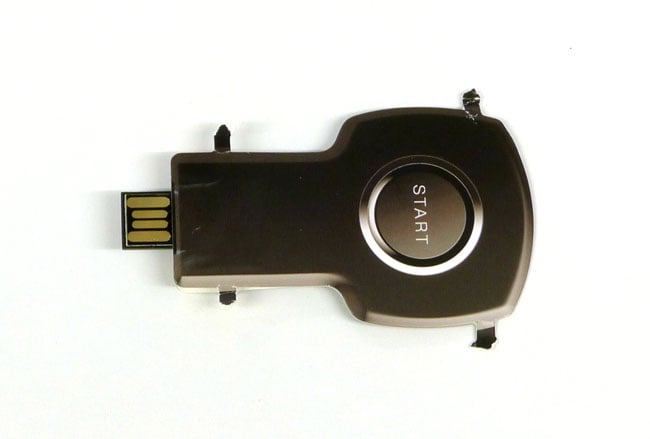
Your (USB) key to the essential driver software
WD supplies the Dual Drive in a kit which includes a Sata-to-USB 3.0 cable for cloning your current drive. When you connect the Dual Drive to your laptop using the USB adapter, you’ll see the 120GB SSD in Windows Explorer but the 1TB hard drive will remain invisible for the time being.
You also get a USB dongle which is a “Web key Internet product” that takes you off to the correct page on WD’s website from which you download the Acronis True Image cloning tool and WD’s Dual Drive installation software.
When two drives go to whirr
The Acronis True Image WD Edition software (version 16 from 2013) insisted that I connect a WD drive first, even though the Dual Drive was connected using the adaptor cable. After a little trial and error, I found that Acronis would only play ball once I used Windows Disk Management to create a partition on the new drive. That done, I had the option to clone the original drive, clean up the disk, destroy data and so on.
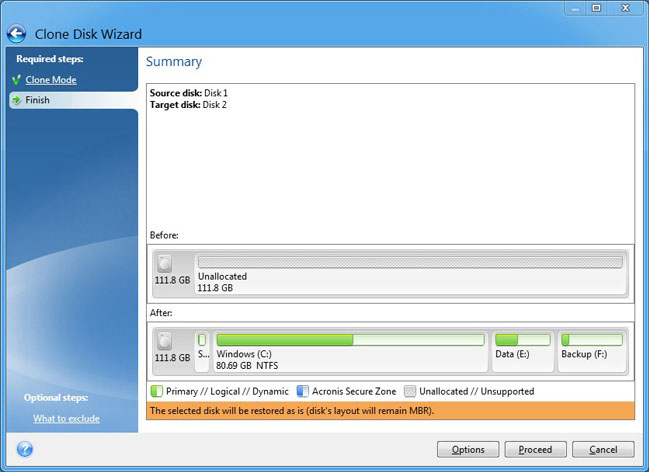
Acronis duplicates your existing drive
The laptop drive that I cloned had three partitions for Windows, data and backup, and the Acronis software cloned all three without trouble. Once the cloning was complete, I removed the original hard drive and plugged the WD Dual Drive in its place. Now it was time to run the WD software to unlock the 1TB hard drive.
At this stage you need to know that the Dual Drive works with Windows XP, Vista, 7 and 8 but not with Mac OS X, at least not until next year. Linux support... well, who can say?
The partition can’t span the SSD and HDD, and WD doesn’t support Nvidia and ASMedia SSD controllers, although that is more likely to bother desktop PC users than owners of laptops.
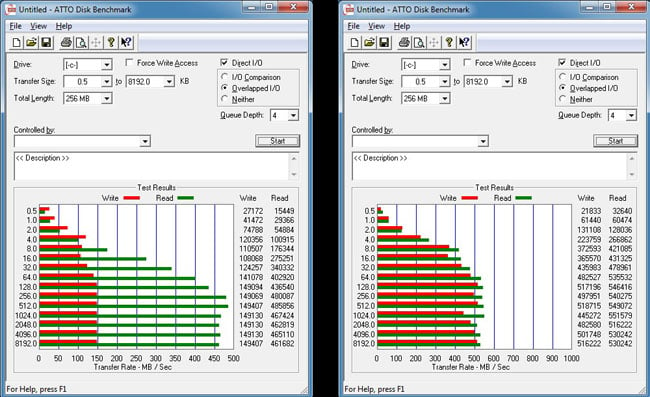
ATTO SSD benchmark results: SanDisk’s Extreme II SSD (left) vs WD’s Dual Drive SSD (right)
Click for larger image
Once the Dual Drive installation software had loaded the bridge chip drivers, the system restarted and the 1TB partition was created before the system booted into Windows. I now had two visible drives in Windows Explorer with a combined formatted capacity of just over 1TB.
The HDD compares favourably with a 1TB Seagate SSHD hybrid drive, although it is a few percentage points slower at every step and is noticeably slower than the new 7mm 500GB Toshiba MQ01ACF hard drive.
When I duplicated 2GB of music files on each drive there was a noticeable gulf, with the Seagate doing the job in 16.7 seconds and the Toshiba in 21.8 seconds while the Dual Drive HDD took 32.3 seconds.
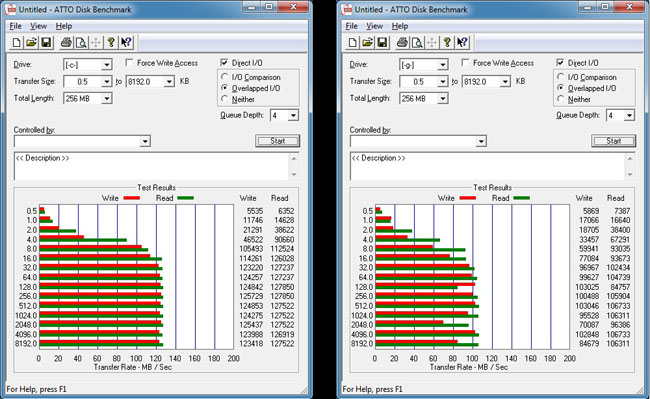
ATTO SSD benchmark results: Toshiba’s MQ01ACF HDD (left) vs WD’s Dual Drive HDD (right)
Click for larger image
Interestingly, the Dual Drive SSD took 28.6 seconds; much slower than a SanDisk Extreme II SSD, which copied the files in 5.1 seconds. In other respects, the WD SSD flew through the benchmarks and trounced the hard drives but was unable to keep up with the SanDisk SSD.
The Dual Drive feels like a decent HDD and a slowish SSD that have something holding them back - probably the Marvell bridge chip which is managing the Sata interface.
I can show you a convincing reason why you should consider the Dual Drive: starting 64-bit Windows 7 on my Core i7 took 42.7 seconds using the Toshiba HDD whereas the SanDisk Extreme II took 22.3 seconds. The WD Dual Drive won the race: it took 19.5 seconds.
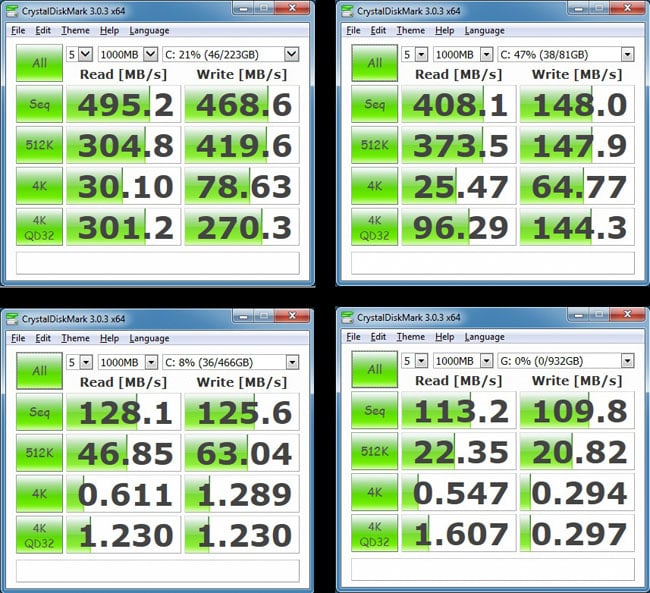
CrystalDiskMark Results - clockwise from top left: SanDisk Extreme II SSD, WD Dual Drive SSD, WD Dual Drive HDD, Toshiba MQ01ACF HDD
Click for a larger image
And so we come to the big question: should you spend £249 on a 1TB WD Dual Drive? Clearly not if you have a Mac – or at least, not until the Mac software is released in 2014.
If you can afford £480 for a 1TB Samsung 840 Evo SSD then I suggest you avail yourself of one, as it is an act of charity to remove spinning magnetic media from your laptop.
If you like the idea of a WD Dual Drive but hate the thought of spending £249 on a 1TB HDD, I sympathise and point you towards the 1TB Seagate SSHD, which will set you back just £85. Or you can buy a 1TB WD Scorpio Blue HDD for 60 quid.
If you don’t need 1TB or 750GB then the smart thing to do is to buy the most affordable SSD that you can stomach. My suggestions include the £150 240GB SanDisk Extreme II, the 480GB Crucial M500 and the 500GB Samsung 840 Evo. The last two are both priced at £290, a whisper more than the Dual Drive.
The Reg Verdict
If you have a Windows laptop with a single drive bay AND you need more than 500GB of storage AND you don’t want to spend more than £250 AND you’re not too concerned about performance THEN I strongly recommend the WD Black² Dual Drive. But that’s a LOT of ‘ands’. ®